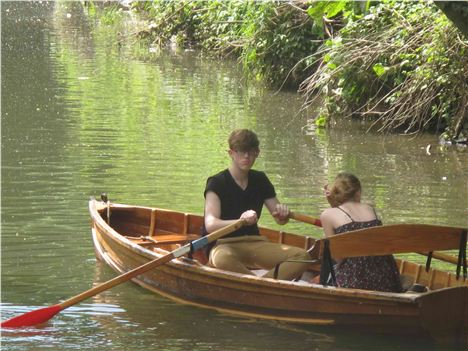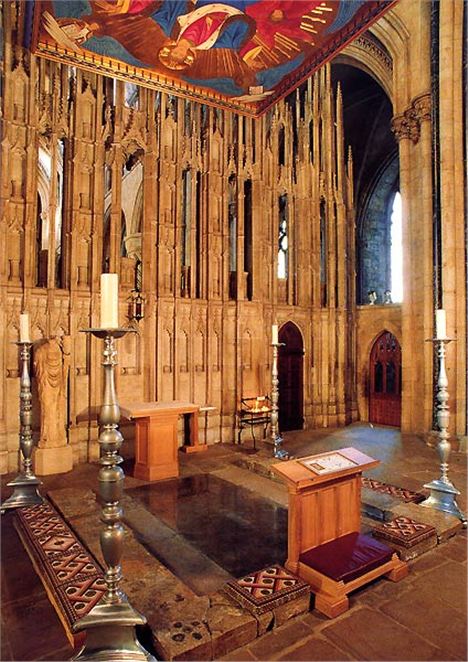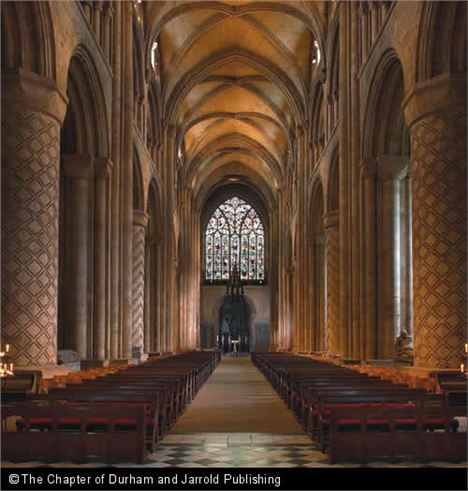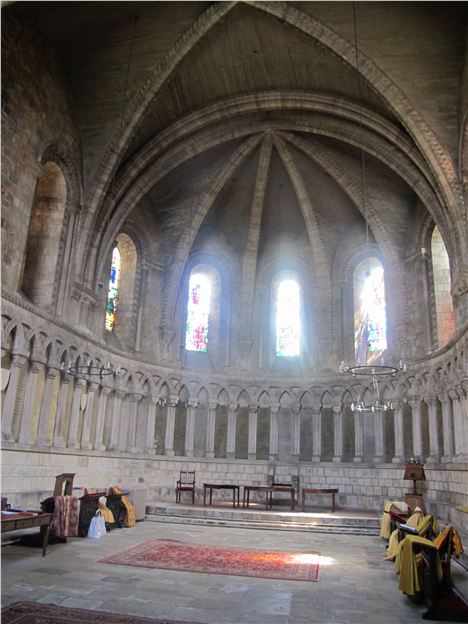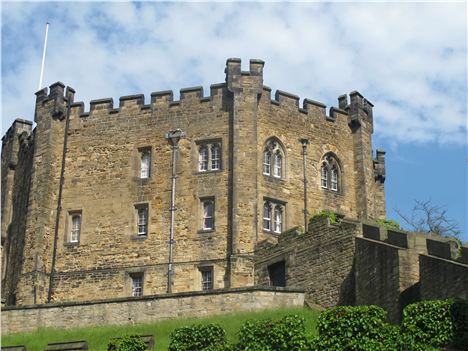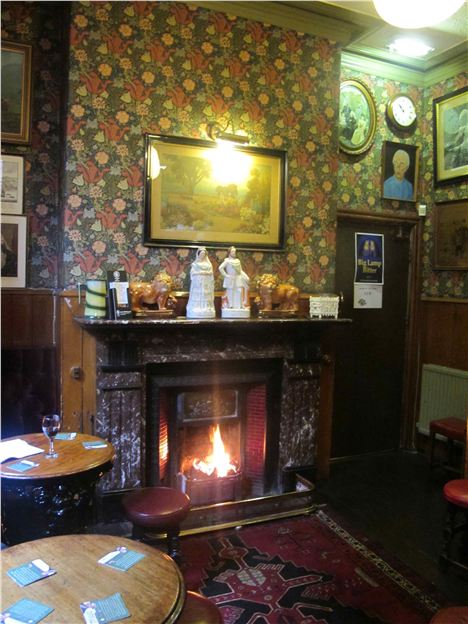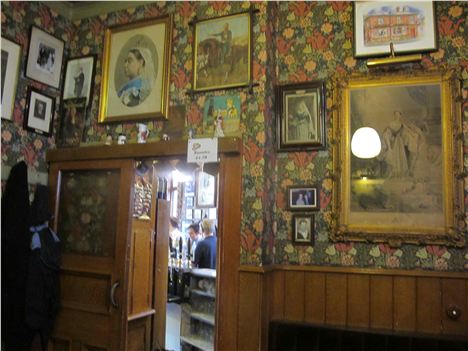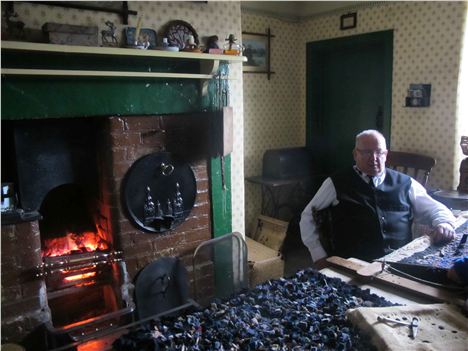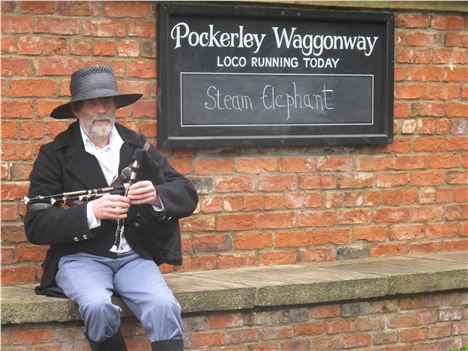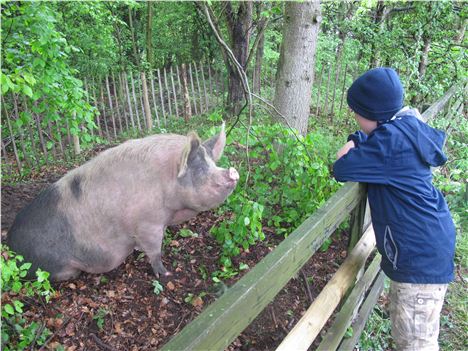WHEN you’ve been lugging a Saint’s body around for almost a century you are about ready for some divine intervention to lay him in a final resting place. That’s where the Dun Cow comes in. Legend has it. Without the straying beast this posse of monks, fleeing the Viking threat, might never have come upon the site of Durham.
'The skins of 128 calves were used to make the Lindisfarne Gospels and the bound book weighs 8.7kg or as much as an adult badger'
And without the holy men Britain’s best loved building, the city’s Cathedral, would never have arisen on its crag above the River Wear. This summer Durham is hosting a spectacular celebration of its founding father, Saint Cuthbert, who is buried in that iconic church. Europe’s oldest surviving bound book, created in his honour, The Lindisfarne Gospels will be on display in the city.
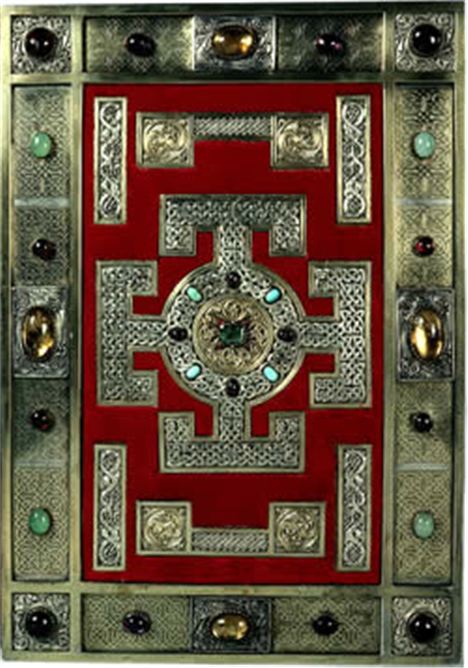 Cover of The Lindisfarne Gospels
Cover of The Lindisfarne Gospels
For the first time in one exhibition this illuminated manuscript will be shown alongside all the saint’s artefacts that arrived with him in the 10th century, including a jewelled cross, sapphire ring and travelling altar. The show and numerous linked events offer a perfect excuse to visit one of Britain’s great destinations. If you really needed one – because Durham’s a treat any time.
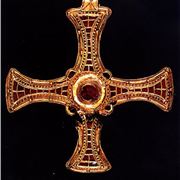 St Cuthbert's CrossBut back to that consequential cow. When Lindisfarne was ravaged by the Danes, the monks had quit their monastery with all they could carry, including Cuthbert’s remains, and embarked on a century of wandering. They were journeying back to a previous haven at Chester-le-Street when the cart carrying the coffin suddenly stopped and could not be moved. Their leader, Bishop Aldhun, had a vision of St Cuthbert demanding to be taken to a place called Dunholme, but nobody knew where that was.
St Cuthbert's CrossBut back to that consequential cow. When Lindisfarne was ravaged by the Danes, the monks had quit their monastery with all they could carry, including Cuthbert’s remains, and embarked on a century of wandering. They were journeying back to a previous haven at Chester-le-Street when the cart carrying the coffin suddenly stopped and could not be moved. Their leader, Bishop Aldhun, had a vision of St Cuthbert demanding to be taken to a place called Dunholme, but nobody knew where that was.
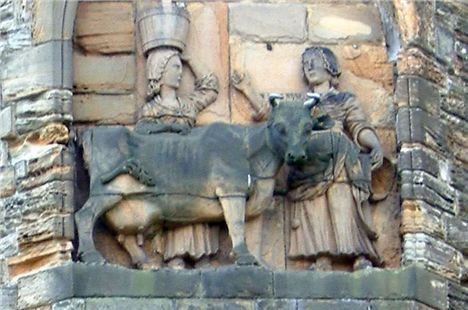 The Dun Cow story as depicted in an 18th century panel on the north facade
The Dun Cow story as depicted in an 18th century panel on the north facade
Then a cow girl came past and asked another young woman if she had seen a lost dun (brown) cow. She had and pointed her towards what sounded like “Dunholme”. Overhearing, the clerics chose to follow the cow girl and found that St Cuthbert’s coffin moved readily in that direction. The defendable position of Dunholme (Durham) on a craggy peninsula protected by a swirling river might have influenced their decision to put down roots here.
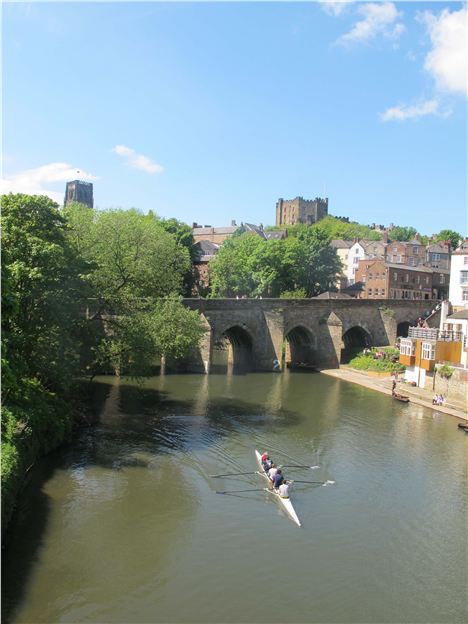 River at Durham; below, time to let our hair down in a skiff
River at Durham; below, time to let our hair down in a skiff
Today, on a summer afternoon river cruise, watching demob happy students carousing after finals and gawping up at the massive sandstone Cathedral and Castle complex that has earned UNESCO World Heritage Status, it takes a huge leap of imagination to enter St Cuthbert’s world. Lindisfarne Gospels www.lindisfarnegospels.com aims to do just that between July 1 and September 30 2013.
I had a sneak preview of the state of the art exhibition space, with elaborate temperature controls, that has been created in the University’s Palace Green Library. Everything was in place except the precious objects.
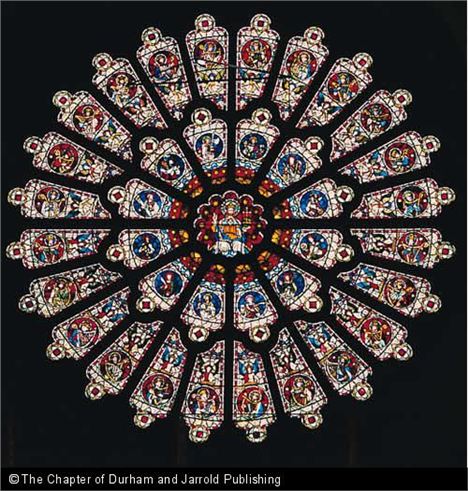 The Rose Window in Durham Cathedral
The Rose Window in Durham Cathedral
The Lindisfarne Gospels/St Cuthbert’s Gospel – written and decorated at the end of the 7th century by the monk Eadfrith – will come up from the British Library in London, where it normally lives a quieter life, to be joined by other important manuscripts from Durham’s own collection.
To whet the appetite, there’s a lovely little pamphlet of interesting facts such as “the skins of 128 calves” were used to make the Gospels but it has been estimated that nearly 400 skins would have been prepared” and the decorated pages were “painted using a brush made of squirrel hair”. Best of all “The Lindisfarne Gospels weighs 8.7kg or as much as an adult badger.”
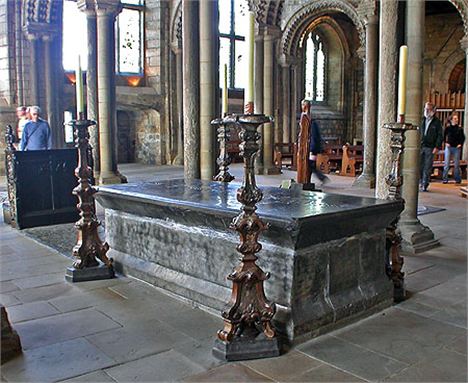 Venerable Bede's Tomb; below, St Cuthbert's Shrine
Venerable Bede's Tomb; below, St Cuthbert's Shrine
I’m sure the Venerable Bede would be impressed. The great Anglo-Saxon scholar’s tomb lies at the other end of Durham Cathedral in the Galilee Chapel – his austere monument in contrast to the major pilgrimage shrine of Cuthbert (I particularly like the damaged statue of the Saint, holding the head of the Northumbrian King Oswald, whose head was reburied with Cuthbert, though the pair weren’t contemporaries).
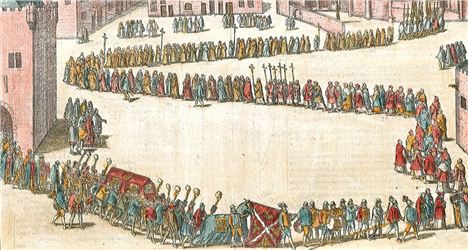 Procession of pilgrims en route to St Cuthbert's Shrine
Procession of pilgrims en route to St Cuthbert's Shrine
It is easy to see why a poll of the UK public voted Durham Cathedral their favourite building. Begun in 1093, this Norman masterpiece, a forest of cylindrical, patterned pillars with an almost Moorish geometry, took just 40 years to complete.
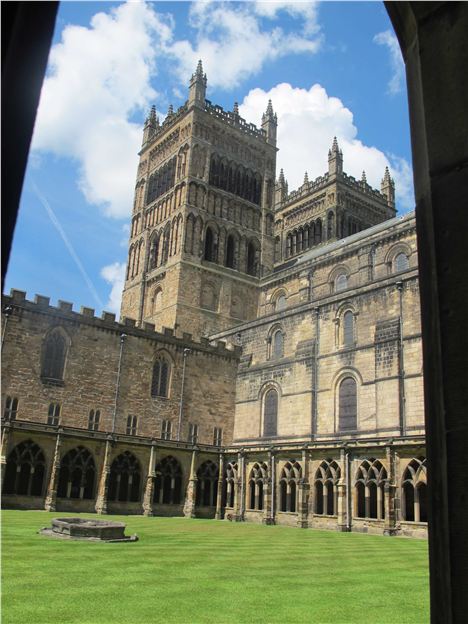 Towers from the Cloisters; below, The Great Nave and the Sacristy
Towers from the Cloisters; below, The Great Nave and the Sacristy
You are able to climb the 325 steps tro the top of the Cathedral – on a clear day you can see the Angel of the North. I recommend taking one of the guided tours here at and also at the adjacent Castle, where it’s the only way you’ll get in. This former Bishop’s Residence in now part of the University and houses some 100 students, mostly in the Norman Keep – the most atmospheric of college halls of residence. Students and staff dine in the vast Great Hall, surveyed by portraits of Bishops past. Tunstall’s Chapel is equally impressive and elsewhere there are some decidedly spooky corners.
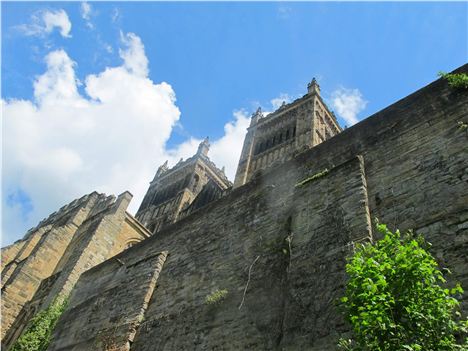 The Cathedral, looking up from the riverbank walk; below, the Castle Keep
The Cathedral, looking up from the riverbank walk; below, the Castle Keep
Lovely though Castle and Cathedral are from close to, the quintessential Durham experience is the sublime view of the soaring towers from a distance. You can walk on both sides of the river loop, keeping an eye out for kingfishers and otters (we saw neither) and the views are constantly changing. Best stroll of all is to the ancient three arch Prebends’ Bridge and entry into the old city through the gates there. The direct route from the town square to the Palace Green via Saddler Street is more prosaic.
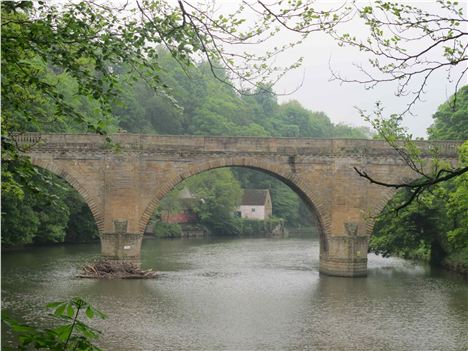 Prebends' Bridge – the quiet back entrance to the ancient city
Prebends' Bridge – the quiet back entrance to the ancient city
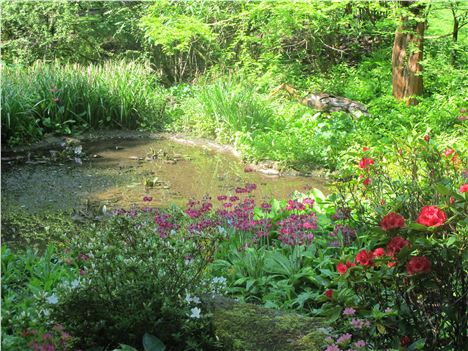 Quiet corner of Durham Botanic Gardens – highly recommended
Quiet corner of Durham Botanic Gardens – highly recommended
Much of the area to the south of Prebends’ Bridge is University Campous territory. Worth the 20 minute walk, though, is the lovely 25-acre Botanic Garden, where we spent an hour of quiet contemplation (www.durham.ac.uk/botanic.garden) and the nearby Oriental Museum, a treasure trove of Far Eastern art (www.durham.ac.uk/oriental.museum).
On the way back divert down busy Hallgarth Street to one of Durham’s great treasures, The Victoria Inn is one of Britain’s best traditional pubs. No music, minimal food (pickled eggs), but unspoilt, listed Victorian multi-roomed interior and there’s a choice of north east cask ales. I didn’t want to leave.
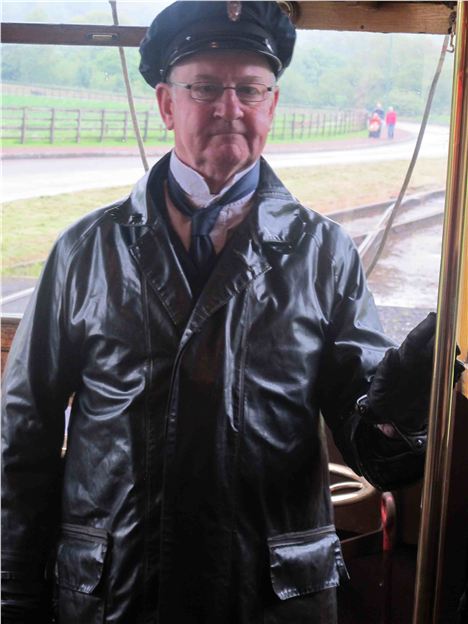 Tram man, Beamish; below costumed volunteers bring the past to life
Tram man, Beamish; below costumed volunteers bring the past to life
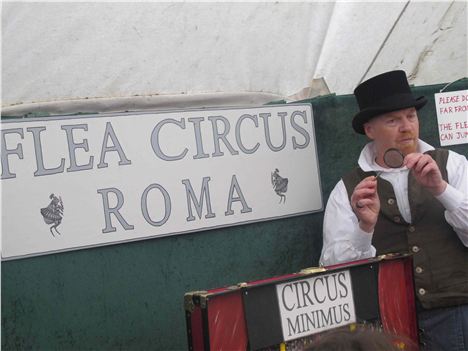 Flea Circus, Beamish; below a piper calls the tune at the Georgian Fair
Flea Circus, Beamish; below a piper calls the tune at the Georgian Fair
For as day out within an easy drive there are many excursions, ranging from the spectacular Bowes Museum at Barnards Castle, quirky Raby Castle to Locomotion, the National Railway Museum at Shildon (see Co Durham website below), but my recommendation would be Beamish, the grandly titled Living Museum of the North, 15 minutes north by car.
It’s not cheap at £17.50 an adult entry, children £10, but there’s enough on its 300 acre open air site linked by a circular tramway to fill a day out. Particularly if you join the lengthy queue at Davy's Coal Fired Fish and Chip Shop! The site is divided into four sections – Edwardian Town, Pit Village,, Home Farm and Pockerley Old Hall – using buildings brought brick by brick from original sites. The object is to help visitors experience first ahnd how the Industrial Revolution transformed agricultural life in the reason.
If that sounds a bit worthy for what is essentially a theme park , well it is rather, but we had a jolly time on our fleeting visit, mainly thanks to the one-off “Beamish Georgian Fair” at Pockerley Waggonway. Lots of costumed folk playing the Squire or the Northumbrian pipes, a flea circus, coconut shy, bed of nails, clog dancers and a quack doctor all added to the gaiety, but stand-out for me involved a seven-year-old white cross saddleback.
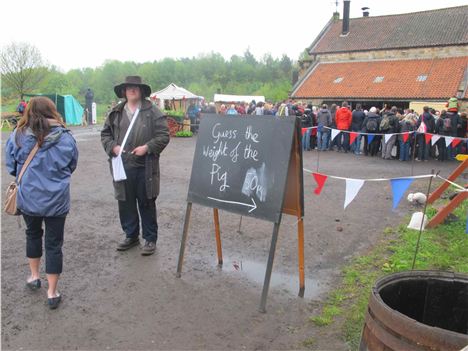 Guess The Pig's Weight competition; below, Hello Miss Winky
Guess The Pig's Weight competition; below, Hello Miss Winky
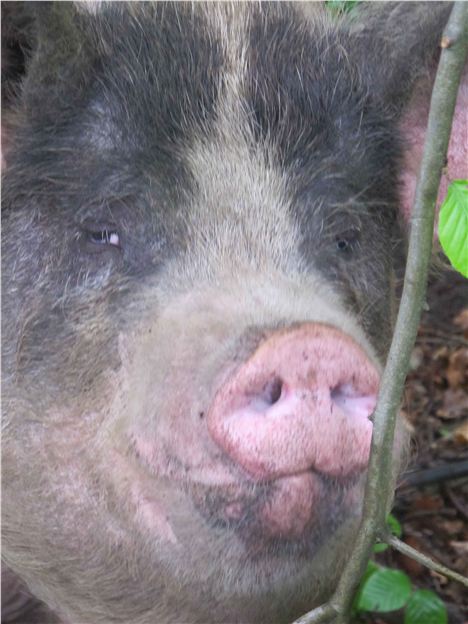 Beamish pig Miss Winky demands her "close up, Mr de Mille"
Beamish pig Miss Winky demands her "close up, Mr de Mille"
Yes, roll up, roll up. For the first time ever there was a chance to guess the weight of Beamish’s resident pig, Miss Winky. Prize – an unlimited Beamish pass. My estimate was way under. Winky was the size of a Shetland pony but heavy-boned, as they say.
What must it have been like carrying Saint Cuthbert’s coffin about for all those decades?
Who was St Cuthbert? 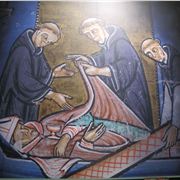 CUTHBERT was probably born near Melrose in Scotland in 633AD, had a holy vision at 18 but served as a soldier before taking orders and becoming a Prior. His original mission to Lindisfarne was to ease the transition from Celtic to Roman Christianity there, but soon he opted for a hermit’s life. He died in 687 and was buried on Lindisfarne – 11 years later his tomb was reopened and they found his body had not decomposed – a story promulgated by Bede’s life of the Saint. Pilgrims flocked, miracles were reported and Cuthbert was canonised. Two centuries later the Holy Island monks fled the Vikings, taking with them the relics of the Saint and the Gospels. They found a home in Chester-le-Street for seven years but further threats of Danish invasion drove them to Ripon.They were on their way back to Chester-le-Street when the cow stepped in. Times are easier for a contemporary cleric, Justin Welby, recently swept from Durham into the Archbishopric of Canterbury.
CUTHBERT was probably born near Melrose in Scotland in 633AD, had a holy vision at 18 but served as a soldier before taking orders and becoming a Prior. His original mission to Lindisfarne was to ease the transition from Celtic to Roman Christianity there, but soon he opted for a hermit’s life. He died in 687 and was buried on Lindisfarne – 11 years later his tomb was reopened and they found his body had not decomposed – a story promulgated by Bede’s life of the Saint. Pilgrims flocked, miracles were reported and Cuthbert was canonised. Two centuries later the Holy Island monks fled the Vikings, taking with them the relics of the Saint and the Gospels. They found a home in Chester-le-Street for seven years but further threats of Danish invasion drove them to Ripon.They were on their way back to Chester-le-Street when the cow stepped in. Times are easier for a contemporary cleric, Justin Welby, recently swept from Durham into the Archbishopric of Canterbury.
The Lindisfarne Gospels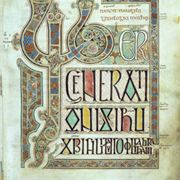 ONE of the most magnificent manuscripts of the early Middle Ages, was written and decorated at the end of the 7th century by the monk Eadfrith, who became Bishop of Lindisfarne in 698 and died in 721. Its original leather binding, long since lost, was made by Ethelwald, who succeeded Eadfrith as bishop, and was decorated with jewels and precious metals later in the 8th century by Billfrith the Anchorite. The Latin text of the Gospels is translated word by word in an Old English gloss, the earliest surviving example of the Gospel text in any form of the English language, it was added between the lines in the mid 10th century by Aldred, Provost of Chester-le-Street. Today the manuscript is once again bound in silver and jewels, in covers made in 1852 at the expense of Edward Maltby, Bishop of Durham. The design is based on motifs drawn from the decoration of the manuscript itself.
ONE of the most magnificent manuscripts of the early Middle Ages, was written and decorated at the end of the 7th century by the monk Eadfrith, who became Bishop of Lindisfarne in 698 and died in 721. Its original leather binding, long since lost, was made by Ethelwald, who succeeded Eadfrith as bishop, and was decorated with jewels and precious metals later in the 8th century by Billfrith the Anchorite. The Latin text of the Gospels is translated word by word in an Old English gloss, the earliest surviving example of the Gospel text in any form of the English language, it was added between the lines in the mid 10th century by Aldred, Provost of Chester-le-Street. Today the manuscript is once again bound in silver and jewels, in covers made in 1852 at the expense of Edward Maltby, Bishop of Durham. The design is based on motifs drawn from the decoration of the manuscript itself.
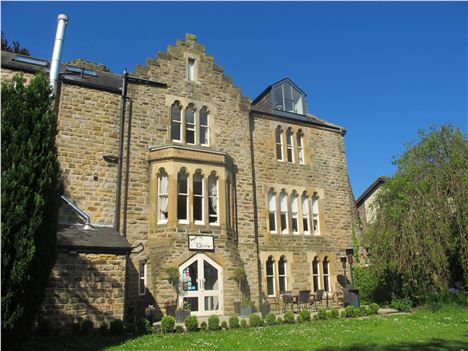 Farnley Tower – a good base for exploring the city, a 15 minute walk away
Farnley Tower – a good base for exploring the city, a 15 minute walk away
Fact file
Getting there:Durham city is a two and half hour car ride from Manchester (over three from Liverpool) via the M62 east and A1 north. Rail links from Transpennine Express. Visit www.tpexpress.co.uk.
Staying there:
Neil Sowerby stayed at the 4-star Farnley Tower, The Avenue, Durham City DH1 4DX . 0191 375 0011 www.farnley-tower.co.uk. Single room £65, double £95, family room £120, all rates include breakfast. Individual, laidback lodgings. Our huge room had a distant view of the Cathedral. Own car park, useful in a city with limited parking.
He dined in the hotel restaurant, The Gourmet Spot, Good Food Guide listed and Michelin-recommended. Tel: 0191 384 6655. http://gourmet-spot.co.uk. Head chef Stephen Hardy is producing some excellent, creative cooking here and deft service compensates for a slightly cramped dining area.
Eating and drinking in Durham:
Taste of Durham monitors food and drink quality in the area’s eateries. Its distinctive mark guarantees their approval. www.tastedurham.co.uk.
On their recommendation we visited Oldfields Noted Eating House, which showcases north east produce. 18 Claypath, Durham DH1 1RH. www.oldfieldsrealfood.co.uk.
Victoria Inn, Hallgarth Street, Durham DH1 3AS. They do accommodation. www.victoriainn-durhamcity.co.uk.
Or if your thirst isn’t sated here, try a brewery visit at the award-winning Durham Brewery, Unit 6A, Bowburn North Ind. Estate, Bowburn DH6 5PF. Visitor centre, bar and shop open every saturday 10am-4pm. Tour at 2pm. Call 0191 377 1991 or visit www.durhambrewery.co.uk.
Essential tourism guides:
For the city: www.thisisdurham.com and for the county: www.visitcountydurham.org.
Durham Cathedral
Tours by team of dedicated volunteer guides. £5. Maureen Martin, who took us round, was brilliant. For more details ring 0191 386 4266 or visit www.durhamcathedral.co.uk.
Lindisfarne Gospels Exhibition, Palace Green Library, Durham. Adults: £7.50 Concessions: £6.50 Under-5s free (2 per paying adult). To book, visit www.lindisfarnegospels.com/tickets or call Ticketmaster on 0844 248 2013.
Prince Bishop River Cruises, £7 a head, children £4, one hour, from Elvet Bridge. www.princebishoprc.co.uk.
Crook Hall Gardens, privately-owned 13th century hall with stunning gardens in the heart of the city. Sidegate, Durham DH1 5SZ. Adults £6.50. www.crookhallgardens.co.uk.
Beamish Open Air Museum, Beamish, Co Durham DH9 0RG www.beamish.org.uk.









